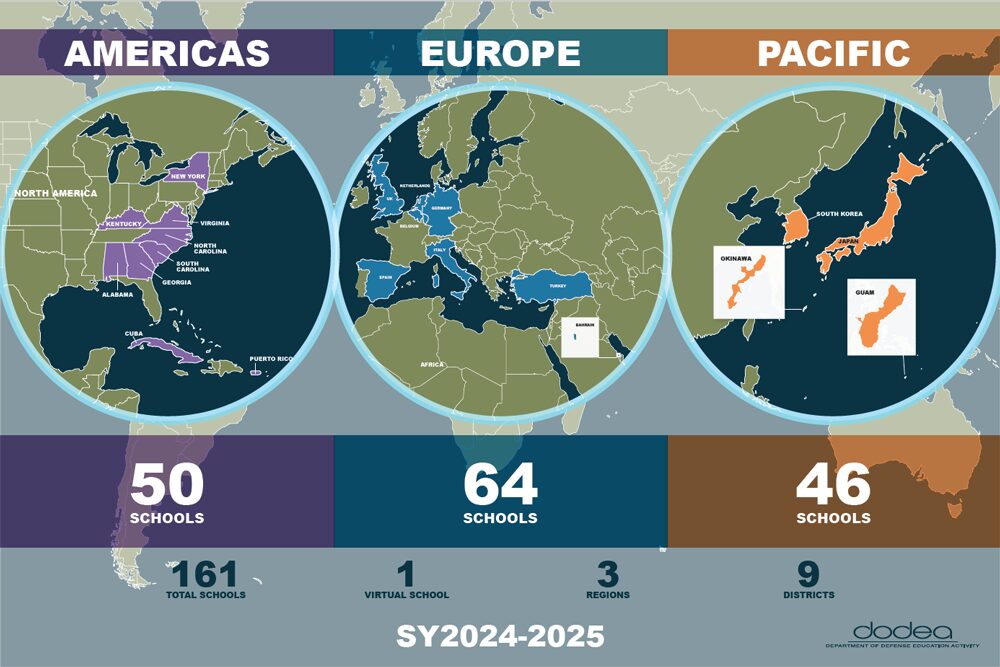

McBride Elementary at Fort Moore in Columbus, Georgia, is one of the 161 schools in the global Department of Defense Education Activity system.
U.S. Army aerial photo of Fort Benning and the Maneuver Center of Excellence by Patrick A. Albright
Quick … before the U.S. Department of Education is put on detention, suspended or expelled completely, grab ahold of deep data analysis released this week by the National Assessment of Educational Progress (NAEP) from the National Center for Education Statistics, the department’s primary statistical agency housed within the Institute of Education Sciences.
For those site seekers who pay close attention to the K-12 education metric, the scorecard shows which states and regions are excelling in math and reading … or, if not excelling, at least not falling further back. The overall results, however, were less sanguine. “The most notable challenges evident in the 2024 data are in reading comprehension,” said an NAEP press release on Wednesday. “Reading scores dropped in both fourth and eighth grades since 2022, continuing declines first reported in 2019, before the pandemic.”
“Overall, student achievement has not returned to pre-pandemic performance,” NCES Commissioner Peggy G. Carr said. “Where there are signs of recovery, they are mostly in math and largely driven by higher-performing students. Lower-performing students are struggling, especially in reading.”
Results are tabulated at the fourth grade and eighth grade levels across four subjects, with the most scores in reading and mathematics. Approximately 235,000 fourth-graders from approximately 6,100 schools and 230,000 eighth-graders from approximately 5,400 schools participated in the 2024 mathematics and reading assessments. The 52 jurisdictions examined include not only the 50 states but also the District of Columbia and the Department of Defense Education Activity (DoDEA, which operates 161 schools in nine districts located in 11 foreign countries, seven states and two territories). The report card also includes district-level findings in 29 city or county school systems.
NAEP achievement levels are performance standards that describe what students should know and be able to do. Results are reported as percentages of students performing at or above three achievement levels (NAEP Basic, NAEP Proficient, and NAEP Advanced).
“In 2024, the percentage of eighth graders reading below NAEP Basic was the largest in the assessment’s history [since 1969], and the percentage of fourth graders who scored below NAEP Basic was the largest in 20 years,” NAEP said. However, “two states stand out for exceeding their 2019 scores in 2024: Alabama scored higher in fourth-grade mathematics, and Louisiana scored higher in fourth-grade reading.”
Students performing at or above the NAEP Proficient level on NAEP assessments demonstrate solid academic performance and competency over challenging subject matter.
“In 2024, 28% of eighth-grade students performed at or above NAEP Proficient in mathematics, which was two percentage points higher compared to 2022 and six percentage points lower compared to 2019,” the report stated. “Thirty-nine percent of eighth-graders performed below NAEP Basic, which was one percentage point higher than in 2022 and eight percentage points higher compared to 2019.”
Here we examine one slice of the findings: eighth grader performance, where results “show widening gaps since 2022 between higher- and lower-performing students as higher performers regained ground lost and their lower-performing peers continued to decline or show no notable progress,” NAEP said.
Themes Emerge in Reading Results
Reading scores for eighth-grade public school students saw no significant change in 44 states/jurisdictions and a decrease in eight others, including the three contiguous states of Utah, Nevada and Arizona. The NAEP noted variations across regions and community sizes: “At eighth grade, average reading scores have declined in the South and West since 2022. For eighth-grade students in city, suburban, and town schools, average reading scores declined, driven by lower-performing students. There is no measurable change in the average reading score for eighth-graders at rural schools.”
“Nationally, 29% of eighth-grade public school students performed at or above NAEP Proficient in reading in 2024, which was not significantly different from 2022,” the report found. Across the states/jurisdictions, the percentages of eighth-grade public school students performing at or above NAEP Proficient in reading ranged from 19% to 53%.
Judging by lag time online, the robust NCES data resources at its “The Nation’s Report Card” site are a bit overtaxed at the moment. But they allow for downloading of complete data tables and provide snapshots of all states and local districts.
Who achieved the 53% level? DoDEA, whose schools serve more than 64,000 students. The DoDEA education level provides one more reason why companies like proximity to military-friendly communities and populations of military families and veterans.

The DoDEA system encompasses 161 schools in nine districts located in 11 foreign countries, seven states and two territories.
Map courtesy of DoDEA
Here are the top 10 states/jurisdictions and ties by percentage of eighth-grade public school students at or above NAEP Proficient in reading:
| State/Jurisdiction | Percentage |
| 1. DoDEA | 53% |
| 2. Massachusetts | 40% |
| 3. New Jersey | 38% |
| T4. Connecticut | 35% |
| T4. Colorado | 35% |
| 6. New Hampshire | 34% |
| T7. Indiana | 33% |
| T7. Maryland | 33% |
| T7. Illinois | 33% |
| T10. Idaho | 32% |
| T10. Ohio | 32% |
Among the 29 districts, only one showed an increase in eighth grader reading scores: Chicago, where the percentage of students at or above NAEP Proficient rose from 21% to 27%. Two percentage points below the national average may not exactly be cause for celebration, but it demonstrates improvement nonetheless.
Here are the top systems and ties in that group of 29 by percentage of eighth-grade public school students at or above NAEP Proficient in reading:
| School System | Percentage |
| 1. San Diego | 37 |
| T2. Austin | 31 |
| T2. Denver | 31 |
| 4. New York City | 29 |
| 5. Miami | 28 |
| T6. Charlotte | 27 |
| T6. District of Columbia | 27 |
| T6. Chicago | 27 |
| T9. Boston | 26 |
| T9. Hillsborough County (Tampa) | 26 |
Calculating the Math Scores
DoDEA is No. 1 in math too.
“In the five states/jurisdictions with a higher percentage of students performing at or above NAEP Proficient in mathematics in 2024, increases ranged from four to six percentage points,” the report states. “Nationally, 27% of eighth-grade public school students performed at or above NAEP Proficient, which was one percentage point higher compared to 2022.” Across the states/jurisdictions in 2024, the percentage of eighth-grade public school students performing at or above NAEP Proficient ranged from 14% to 41%.
Here are the top 10 states/jurisdictions and ties by percentage of eighth-grade public school students at or above NAEP Proficient in mathematics:
| State/Jurisdiction | Percentage |
| 1. DoDEA | 41 |
| T2. Massachusetts | 37 |
| T2. New Jersey | 37 |
| T2. Wisconsin | 37 |
| 5. Utah | 35 |
| 6. Minnesota | 34 |
| 7. South Dakota | 33 |
| T8. Nebraska | 32 |
| T8. Colorado | 32 |
| T8. Illinois | 32 |
| T8. Montana | 32 |
| T8. Ohio | 32 |
| T8. New Hampshire | 32 |
| T8. Connecticut | 32 |
Illinois showed the largest improvement in percentage at the NAEP Proficient level (6%), though it was down 1% from its pre-pandemic achievement level in 2019.
Among 26 trial urban district assessment districts, the scorecard results point to the following leaders in eighth grader mathematics scores at or above NAEP Proficient:
| School System | Percentage |
| 1. Charlotte | 32 |
| 2. San Diego | 31 |
| 3. Austin | 29 |
| 4. Guilford County (NC) | 25 |
| T5. Denver | 24 |
| T5. Boston | 24 |
| 7. New York City | 23 |
| T8. Miami | 22 |
| T8. District of Columbia | 22 |
| 10. Chicago | 21 |
DoDEA’s exemplary performance was spelled out in a detailed and lengthy memo yesterday, suitably filled out with graphs and charts. DoDEA students’ average scale scores ranged from 14 to 25 points higher than corresponding national average scores and held steady while national average scores mostly decreased.
“I am delighted that DoDEA has once again performed exceptionally well on the National Assessment of Educational Progress,” said DoDEA Director Dr. Beth Schiavino-Narvaez. “Credit for this success belongs to our incredible teachers, administrators, and staff of DoDEA, and most importantly to our students and their families, for all their hard work and dedication. Our relentless pursuit of continuous improvement has empowered our mission to deliver excellence in education to every student, every day, everywhere.”